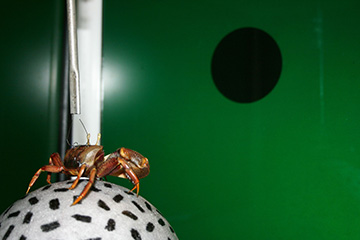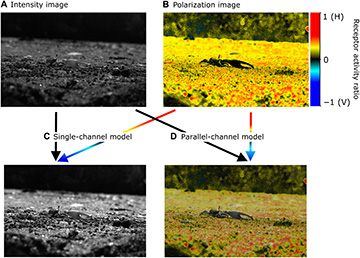
Experimental setup depicts a tethered fiddler crab on a spherical treadmill staring at a looming circle meant to simulate a predator on the researchers’ intensity–polarization screen. [Image: Sam Smithers, University of Bristol]
Certain crustaceans, such as fiddler crabs, have a well-known sensitivity to the polarization of light, and use this visual information to inform their movements and behaviors. This extra visual cue, which the human visual system does not provide, can give crabs a leg up (or two or three) when faced with a potential threat.
Just how this information is processed, though, has been obscure. Researchers from the Ecology Vision Group at the University of Bristol, U.K., have devised a way to see through crabs’ eyes, and they’ve found that the cryptic critters handle their perceptions of polarization and brightness independently and in parallel (Sci. Adv., doi: 10.1126/sciadv.aax3572).
Unraveling dipolat vision
Creatures throughout the animal kingdom—insects fish, cephalopods and, of course, crustaceans—take advantage of polarization sensitivity to guide decision-making for everything from navigation to communication. This information can enhance the visual contrast, say, of an incoming predator against its background.
Crabs, along with other crustaceans, have dipolat polarization vision—a two-channel arrangement in which horizontal and vertical photoreceptor cells are oriented perpendicular to each other. In this arrangement, the visual data from each of the photoreceptors then synapses with three types of descending neurons deeper in the visual system: two preserve the vertical and horizontal channels of polarization data, and the third combines the input to create a polarization-independent brightness channel.
Parallel or single-channel model?
Intensity (A) and polarization (B) images are combined to enhance intensity contrast through the single-channel model (C) or as separate layers of contrast information using the parallel-channel model (D). [Image: S. Smithers et al., Sci. Adv. 5(8), eaax3572 (2019); CC-BY 4.0][Enlarge image]
The question that the Bristol team wanted to unravel was, how do these data inform task-specific behaviors once the data are processed further in the brain? Does the animal receive a combined representation of visual contrast in a single channel? Or, can crabs see both polarization and intensity as separate layers of contrast information, in parallel channels?
The main advantage of the parallel-channel model is that it provides a richer visual dataset. For fiddler crabs in particular, which reside in polarization-packed mudflat environments against which an unpolarized predator would visually “pop,” this model allows for an advantageous field of view that includes both polarization contrast and intensity cues.
To put the model to the test, the Bristol team devised a set of behavioral experiments, exposing the crabs to a range of stimuli that varied in polarization, brightness or both. It predicted that if the crabs had a single-channel vision system, then the creature’s vision would suffer from points at which intensity and polarization would cancel each other out at a specific contrast level. If there were no such cancellation points, then the parallel-channel option would be the winner.
It’s a bird, it’s a plane, it’s a predator!
The team loosely tethered the fiddler crabs and placed them, one at a time, onto a spherical treadmill. The researchers then exposed the crabs to different “looming circles” on a custom-built intensity–polarization screen to mimic approaching predators. If the animals froze on the treadmill, then the researchers knew that the crabs had detected the predator.
The key to the Bristol team’s experiments was a cleverly constructed intensity–polarization screen that allowed the researchers to independently adjust the polarization and intensity properties of the stimuli. The screen consisted of two spatially and temporally synchronized displays—a digital projector to control intensity, and an LCD panel from a computer monitor with the front polarizer removed to control polarization.
The team conducted a first series of experiments with polarization-only and intensity-only stimuli, and then repeated the experiments with the addition of a fixed polarization or intensity contrast. In support of the parallel-channel vision model, the researchers found no cancellation points in the data. They concluded that fiddler crabs process polarization and brightness as separate sets of non-conflicting information when viewing a moving object, rather than as a single form of contrast.
These promising results, according to the researchers, show that the way crabs see polarization is more complex and exciting than previously thought. According to an accompanying press release, they plan to push further and find out what happens to the brightness and polarization information deeper in the brain—and exactly when this knowledge begins to profit the viewer and guide its behavior.

